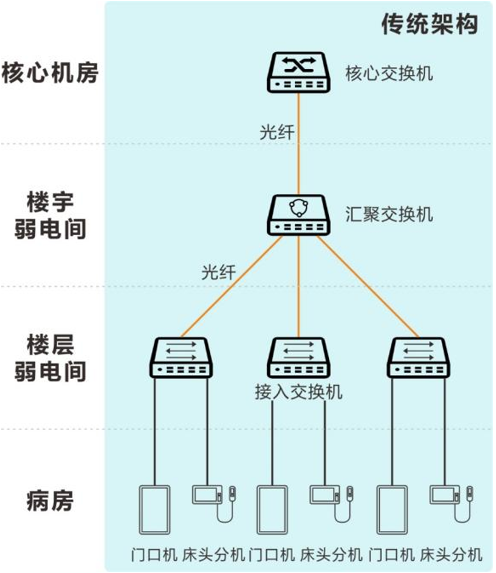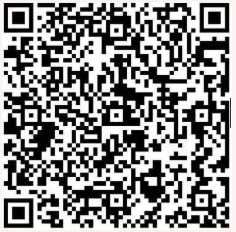
1. Overview
The nursing call signal system in hospital wards is a tool for non-contact real-time communication between hospitalized patients and medical staff. By integrating with the hospital’s information system, it provides diverse intelligent services for the ward and is an essential subsystem in the construction of intelligent hospital systems.
Currently, there are many manufacturers in the industry developing nursing call signal systems. The systems from various manufacturers generally include terminal devices such as nurse station host, room entrance machine, bedside extension, corridor display, and restroom alarm button, but there are some differences in the networking technology of the systems. This article discusses only the differences in networking technology of the nursing call signal system and future development trends.
2. Classification of Nursing Call Signal System Networking Technology
In 2019, the “National Building Standard Design Drawings for Medical Building Electrical Design and Installation” published by the China Academy of Building Research classified nursing call signal systems into two types: bus-type and digital-type[1].
2.1 Bus-type Networking Architecture
The wiring method of the bus-type nursing call signal system uses a single bus to connect various ward terminal devices, communicating based on proprietary protocols defined by each manufacturer. The cabling materials vary due to different technical solutions from manufacturers, including two-core bus types, three-core bus types, etc., each with different restrictions on cable materials and shielding methods.

The bus-type nursing call signal system was developed earlier by manufacturers in the industry, with some using RS485 data communication technology, and voice transmission using analog audio methods. Other manufacturers use power line carrier technology to transmit data and analog audio over a two-core power supply line. The wiring of the bus-type nursing call signal system is relatively simple, and the cost of terminal devices and system integration is lower, but it has deficiencies in signal transmission resistance, long-distance signal transmission, system function customization, and scalability. Early hospital construction of nursing call signal systems mostly adopted bus-type systems, which can meet basic usage needs such as calling, intercom, and nursing information display. Currently, bus-type nursing call signal systems are only selected for first-level hospital projects with low construction budgets, and they are facing obsolescence in secondary and tertiary hospitals.
2.2 Digital-type Networking Architecture
The digital-type nursing call signal system is designed with a digital and networked architecture, based on Ethernet (100M/1G) transmission mode, using the internationally standardized TCP/IP communication protocol. The nurse station host, room entrance machine, bedside extension, and corridor display in the system all use IP network communication technology.
IP network communication technology is one of the most widely used information communication technologies, with advantages in technological advancement, stability, and scalability compared to the communication technologies used in bus-type systems, and it can achieve digital high-definition audio and video communication. However, the cost of terminal devices and the overall system construction cost is higher than that of bus-type nursing call signal systems.
In recent years, with the outbreak of COVID-19, various infectious disease hospitals, infectious disease buildings, and makeshift hospitals have been rapidly constructed and expanded across the country. The main types of medical buildings, such as infectious disease wards and isolation wards, require interactive nursing call systems as technical support. The interactive nursing call system, which allows for two-way (medical staff and patients) visual intercom, greatly reduces the number of contact occasions between medical staff and patients, thereby reducing the risk of infection and saving valuable medical protective equipment materials. The high-code stream signal transmission of this interactive nursing call system requires a reliable support from a digital IP network communication architecture, which cannot be met by the bus-type architecture.
In specific project construction, depending on the different IP network construction architectures of hospitals, the networking connection methods of the digital nursing call signal system can be mainly divided into two types:
2.2.1 “Fiber + Network Cable” Architecture for Digital Nursing Call Signal System Networking Connection
The “Fiber + Network Cable” architecture involves laying network optical fibers to the weak current well on each floor, where the optical signal is converted into an electrical signal through a network switch, and then connected to the nurse station host, room entrance machine, and bedside extension via standard network cables. Currently, most hospitals adopt this method for IP network construction.

2.2.2 Full Optical Network Architecture for Digital Nursing Call Signal System Networking Connection
The full optical network architecture is a communication network where signal transmission and exchange functions are mainly performed in optical state. Optical fibers are laid directly to nurse stations and wards, where optical signals are converted into electrical signals through ONU (Optical Network Unit) and then connected to each nurse station host, room entrance machine, and bedside extension via standard network cables. Currently, the application of full optical network architecture in hospitals is still in its early stages. Considering cost factors (mainly the cost of OLT optical line terminal) and the on-site power supply of ONU, there is no ideal solution yet. Only a few large hospitals with advanced concepts, such as Huazhong University of Science and Technology Union Shenzhen Hospital, Shandong University Qilu Hospital, Guangzhou International Health Station, Central Aid Hong Kong Emergency Hospital, and Lok Ma Chau makeshift facilities project, have adopted full optical network architecture for their IP network construction.

In addition to the two main methods mentioned above, the networking connection of the digital nursing call signal system can also be established using WiFi and broadband power line carrier communication devices. The WiFi networking connection method requires that the hardware of terminal devices must support wireless networking functions. However, the nursing call system signal transmission has very high requirements for long-term stable operation, and the various wireless signals in hospitals, such as 2.4G, 5G, Internet of Things Bluetooth, and indoor distribution, are complexly intertwined, causing electromagnetic signals to interfere with each other, resulting in unstable real-time online transmission of wireless signals. Therefore, this method is usually not selected. Broadband power line carrier communication modulates IP network digital signals onto twisted pairs, coaxial cables, and other media for transmission. This technology and communication method are greatly influenced by the number of access nodes, cable materials, and wiring structures, making signals prone to attenuation and interference, with flexibility and stability inferior to fiber and network cable networking methods. Moreover, it has a fatal weakness: the transmitted signal cannot cross the circuit breaker in the distribution box due to the strong filtering ability of standard circuit breakers, so it can only be used for small-scale networking within wards, and cannot network the entire large ward area, hence this networking form is usually not selected.
[5]
3. Development Trends of Nursing Call Signal System Networking Technology
From the perspective of networking technology, IP network communication technology has incomparable advantages in universality, compatibility, and standardization. The digital nursing call signal system using IP network architecture will not be limited by any manufacturer’s networking connection methods in terms of system upgrades and equipment replacements in the future, will not be bound by any manufacturer’s technical solutions, and will not require reconstruction of existing transmission lines, providing significant cost advantages and universal replaceability in the later usage and upgrades of hospitals.[5]
From the perspective of terminal devices, terminal devices that support IP network communication technology have relatively high hardware performance in chip solutions, using Linux and Android embedded operating systems, providing a basic hardware guarantee for future deep customization and expansion applications in hospitals.
From the perspective of functional expansion, with the application and popularization of technologies such as the Internet, 5G, the Internet of Things, and artificial intelligence, smart wards have begun to enter people’s view. The functions of traditional call intercom signal systems are no longer singular. As the most common bedside terminal in wards, call systems are increasingly taking on important roles in improving work processes for medical staff, enhancing work efficiency, and increasing patient satisfaction, such as achieving high-definition visual intercom, remote video consultations, bedside consultations, and remote ward rounds based on this system, which will also require higher bandwidth, information security, and system scalability. In the future medical service operation and maintenance system, the digital nursing intercom signal system based on IP network technology will play an increasingly important role.[3][4]
The national standard GB51348-2019 “Electrical Design Standards for Civil Buildings” also states in chapter 17 “Call Signal and Information Release Systems” that nursing call signal systems should preferably adopt digital and networked technology forms for networking.[2]
In summary, the digital nursing call signal system based on IP network communication technology is an inevitable trend in the future development of industry technology and products.
References
[1] China Academy of Building Research. 19D706-2. National Building Standard Design Atlas “Electrical Design and Installation of Medical Buildings”, 2019: 92-96.
[2] China Northeast Architectural Design Institute Co., Ltd. GB51348-2019. National Standard of the People’s Republic of China “Electrical Design Standards for Civil Buildings”, 2019: 247.
[3] Wu Yanyan, Tang Yuan. The Role of Intelligent Construction of Hospitals in the Development of Smart Healthcare. Journal of Medical Informatics, 2015: 40.
[4] BOE Technology Group Co., Ltd., Artery Network Eggshell Research Institute. “2021 Smart Hospital Innovation White Paper”, 2021: 16-41.
[5] Wang Cheng. Key Points and Difficulties in the Design of Newly Built General Hospitals, 2022: 291-297.
2022, Shenzhen, see you there!


Email of the New Media Department:

Scan the QR code to follow us
Spread the latest developments in the field of digital medicine and pay attention to information related to medical and health informatization.